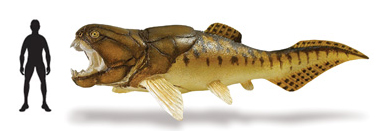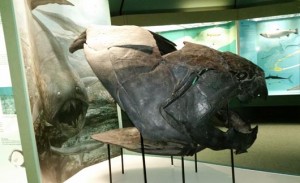Dunkleosteus An Amazing Fish Built like a Bulldozer and a Guillotine for Jaws
Dunkleosteus – The Terror of the Devonian
The Devonian period which lasted approximately sixty-three million years (417 million years to 354 million years ago), is known as the Age of Fishes, as fish were the most advanced vertebrates on the planet for much of the Devonian. Although the Devonian period marks the formation of a supercontinent with the closing of the Lapetus Ocean, life in the oceans still dominated and it was only towards the end of the Devonian that primitive tetrapods began to venture out onto land. Lakes and rivers were becoming populated by fish and the land was forested as plants evolved greater adaptations to a terrestrial habit. Indeed by the Middle Devonian, land plants were becoming more complex and taller and by the end of this geological period the first trees had become established.
Dunkleosteus
Insects diversified and began to increase in number, exploiting the many new opportunities life on land was providing. However, it was in the sea where the truly spectacular animals lurked. The top predators in the marine environment were the newly evolved primitive sharks and the armour plated placoderms such as Dunkleosteus.
A Scale Illustration of Dunkleosteus

Picture credit: Everything Dinosaur
The model in the picture is a Wild Safari Dinos Dunkleosteus model.
Dunkleosteus was a huge prehistoric fish with an armoured head and thorax made up of several interlocking plates. In large specimens (the biggest may have been as long as bus), the armour was up to 5 cm thick. The word placoderm means armoured or plated skin, it is pronounced plak-oh-dermz and this particular group of jawed fish had their origins in the Silurian, rapidly diversified in the Devonian before becoming extinct at the end of this period, leaving a sort of evolutionary dead end. The ancestors of placoderms lacked teeth, instead this group developed a pair of bony plates that hung down from the top jaw, whilst the edges of the lower jaw were also bony and very sharp. When the mouth was closed the jaws sheared against each other making a self-sharpening cutting surface. Dunkleosteus was a top predator and the fossilised remains of regurgitated fish, the remnants of a meal from a Dunkleosteus have been found.
A Replica of the Anterior Portions of the Giant Member of the Placodermi Class – Dunkleosteus
Picture credit: Everything Dinosaur
With jaws like a guillotine and a front end built like a bulldozer, Dunkleosteus was a very formidable predator indeed.
To view a model of Dunkleosteus and other amazing replicas of prehistoric animals, take a look at the PNSO section of the Everything Dinosaur website: PNSO Age of Dinosaurs.


